Cold Water Riding
Kiteboarding Tips
Tip #4 - Cold Water Riding
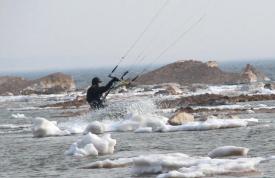 It is spring in the Midwest and everyone is dying to ride. This is a tip that is designed to help you not die. REALLY! Cold water is a very serious safety issue when kiting on the Great Lakes. Even in the summer the Big Lakes can turn over in hours from 70° to 55°. Although the advent of dry suits and great wetsuits has given us the ability to ride in almost any temperature (see photos of Andy), getting stranded in the water for 20-30 minutes can still be life-threatening. Here are some basic rules to keep you safe AND enjoy the spring riding season. Most local riders have a basic rule of thumb for what cold water riding is: When the air and water temps combined are below 110°, it is considered cold. For many people the low-end threshold is a combined total of about 90°. The pictures of Andy are a good example. Water temps 35°-37°, air temps 55°. Total 90°.
It is spring in the Midwest and everyone is dying to ride. This is a tip that is designed to help you not die. REALLY! Cold water is a very serious safety issue when kiting on the Great Lakes. Even in the summer the Big Lakes can turn over in hours from 70° to 55°. Although the advent of dry suits and great wetsuits has given us the ability to ride in almost any temperature (see photos of Andy), getting stranded in the water for 20-30 minutes can still be life-threatening. Here are some basic rules to keep you safe AND enjoy the spring riding season. Most local riders have a basic rule of thumb for what cold water riding is: When the air and water temps combined are below 110°, it is considered cold. For many people the low-end threshold is a combined total of about 90°. The pictures of Andy are a good example. Water temps 35°-37°, air temps 55°. Total 90°.
1) Ride with a buddy - This is by far the most important rule. If you break down you have someone who can help NOW. Having your cell phone or knowing where a nearby phone is can also be very helpful if you can't get your friend out of the water.
2) Be an intermediate level rider - Learning to ride in 40-degree water is a bad idea. If you can't stay upwind, retrieve your board with ease, and water re-launch consistently, it's time to stay home.
3) Have the right gear- If you plan to ride in the spring on the Great Lakes, these are the basics you should have:
- Steamer Wetsuit or Dry Suit - A steamer wetsuit is a suit with seams that are glued and/or blind stitched.
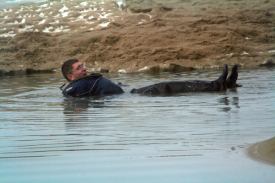 These suits allow very little water "flush" when coming in and out of the water. Most are called 5/3 or 4/3 based on the core area thickness (5mm or 4mm) and the arm and leg thickness (3mm). A 3/2 spring suit that allows water to flush (non-glue or blind stitched) is good when the water temperatures are over 60°. A dry suit will keep all water out of your suit, and it is very comfortable to have fleece against your skin.
These suits allow very little water "flush" when coming in and out of the water. Most are called 5/3 or 4/3 based on the core area thickness (5mm or 4mm) and the arm and leg thickness (3mm). A 3/2 spring suit that allows water to flush (non-glue or blind stitched) is good when the water temperatures are over 60°. A dry suit will keep all water out of your suit, and it is very comfortable to have fleece against your skin. - Booties - Since your feet are constantly wet, booties are a must in water temps under 50°. I like to wear them until the 60-degree mark. We recommend a 4-5mm boot for cold water riding (under 50°) and 2-3mm for warmer water. Some hard-core riders shed boots at around 50° because they love the board contact on their bare feet. Remember - it is usually your extremities that get cold first.
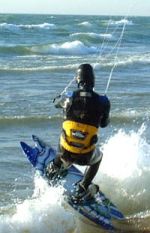 Hood, Beanie or Head Band - The first place to lose heat is the head- up to 55% of your heat loss is through your head. For really cold days, a hood is an excellent choice. For nice warm days with cold water a Beanie or a Head Band will work great. Remember that you WILL crash and dunk your head in the ice-cold water - major ice cream headache with no protection.
Hood, Beanie or Head Band - The first place to lose heat is the head- up to 55% of your heat loss is through your head. For really cold days, a hood is an excellent choice. For nice warm days with cold water a Beanie or a Head Band will work great. Remember that you WILL crash and dunk your head in the ice-cold water - major ice cream headache with no protection.- Gloves or Mittens - This is the area where people will shed protection first, but also seems to be the area when it is really cold that first drives riders off of the water.
- Poly pro undergarments - They add a bit of insulation and help keep the core warm. These are not a must, but really help extend your riding time and comfort level.
4) Check your gear - This is a must for early riding. Does your leading edge leak? Is your chicken loop going to break? Can you get your booties into your board straps and are the screws cranked down? Let's face it- no one is going to show up in a boat to come rescue you when you get stranded. Be prepared.
5) Life Vest - Often people ride without life vests since they have confidence in their water skills and the fact that many other people are on the water. A little extra floatation will keep your head out of the drink and give you a few more minutes if you are in big trouble.
Skip and Brad, two local water men with over 25 years of experience have written a couple of excellent articles on the subject - go to Kiteboarding Safety in Cold Water.
To check out more of the amazing photos and a video of Andy go to www.mackiteboarding.com/icebergkicker.htm
Rider News & Info
Andy's Slider Park
 I got the call on Sunday afternoon - "Hey Steve, do you want to go ride? My wife is sick and I have 3 kids around my legs." Sorry, I can't ride, but I will provide backup if needed. I make sure to grab my camera. I get to the beach and the ice is perfect for getting in and out of, so I'm thinking Andy will have some really cool shots of himself riding around the icebergs. Noah shows up without his gear so he gets Andy's movie camera.
I got the call on Sunday afternoon - "Hey Steve, do you want to go ride? My wife is sick and I have 3 kids around my legs." Sorry, I can't ride, but I will provide backup if needed. I make sure to grab my camera. I get to the beach and the ice is perfect for getting in and out of, so I'm thinking Andy will have some really cool shots of himself riding around the icebergs. Noah shows up without his gear so he gets Andy's movie camera.
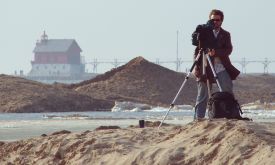 Andy gets in the water for the first time since January. He starts slow and starts to get the groove back. Next thing I see he is trying kite loops. Go Andy. He is really starting to get fired up now and comes and switches his 16.5 Contra down to his 12 meter. I am shooting pictures like mad and Noah is filming non-stop.
Andy gets in the water for the first time since January. He starts slow and starts to get the groove back. Next thing I see he is trying kite loops. Go Andy. He is really starting to get fired up now and comes and switches his 16.5 Contra down to his 12 meter. I am shooting pictures like mad and Noah is filming non-stop.
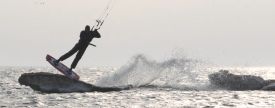 Andy then decides that he can ride on and through the ice and slush. It starts with hitting little chunks and blasting through the slush. Then it is a nice little 1-foot kicker he hits a few times.
Andy then decides that he can ride on and through the ice and slush. It starts with hitting little chunks and blasting through the slush. Then it is a nice little 1-foot kicker he hits a few times.
 Wham! -out of the blue I watch him climb the big kicker; he stops on top and looks around. Noah and I are laughing and hooting - this is pretty crazy from our vantage point - an 8-foot drop to the water with no speed.
Wham! -out of the blue I watch him climb the big kicker; he stops on top and looks around. Noah and I are laughing and hooting - this is pretty crazy from our vantage point - an 8-foot drop to the water with no speed.
Well, now Andy is going to score - he must have hit the berg 12-15 times. It was great- Mother Nature built the perfect-angled kicker for the wind speed that day.
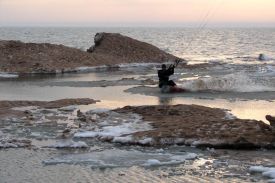 Thanks for the ride, Andy - it was definitely one of the coolest things I will ever see kiteboarding.
Thanks for the ride, Andy - it was definitely one of the coolest things I will ever see kiteboarding.
Also, welcome Andy on board as an instructor for MACkite this year. We look forward to seeing some more great adventures and a new video in the spring of '08.
To check out more of the amazing photos and a video of Andy go to www.mackiteboarding.com/icebergkicker.htm
